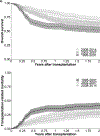Reduction in Mortality after Umbilical Cord Blood Transplantation in Children Over a 20-Year Period (1995-2014)
- PMID: 30481599
- PMCID: PMC6453734
- DOI: 10.1016/j.bbmt.2018.11.018
Reduction in Mortality after Umbilical Cord Blood Transplantation in Children Over a 20-Year Period (1995-2014)
Abstract
Infections and graft-versus-host disease (GVHD) have historically resulted in high mortality among children undergoing umbilical cord blood transplantation (UCBT). However, recent advances in clinical practice have likely improved outcomes of these patients. We conducted a retrospective cohort study of children (<18years of age) undergoing UCBT at Duke University between January 1, 1995 and December 31, 2014. We compared 2-year all-cause and cause-specific mortality during 3 time periods based on year of transplantation (1995 to 2001, 2002 to 2007, and 2008 to 2014). We used multivariable Cox regression to identify demographic and UCBT characteristics that were associated with all-cause mortality, transplantation-related mortality, and death from invasive aspergillosis after adjustment for time period. During the 20-year study period 824 children underwent UCBT. Two-year all-cause mortality declined from 48% in 1995 to 2001 to 30% in 2008 to 2014 (P = .0002). White race and nonmalignant UCBT indications were associated with lower mortality. Black children tended to have a higher risk of death for which GVHD (18% versus 11%; P = .06) or graft failure (9% versus 3%; P = .01) were contributory than white children. Comparing 2008 to 2014 with 1995 to 2001, more than half (59%) of the reduced mortality was attributable to a reduction in infectious mortality, with 45% specifically related to reduced mortality from invasive aspergillosis. Antifungal prophylaxis with voriconazole was associated with lower mortality from invasive aspergillosis than low-dose amphotericin B lipid complex (hazard ratio, .09; 95% confidence interval, .01 to .76). With the decline in mortality from invasive aspergillosis, adenovirus and cytomegalovirus have become the most frequentinfectious causes of death in children after UCBT. Advances in clinical practice over the past 20years improved survival of children after UCBT. Reduced mortality from infections, particularly invasive aspergillosis, accounted for the largest improvement in survival and was associated with use of voriconazole for antifungal prophylaxis.
Keywords: Aspergillosis; Children; Introduction; Race; Survival; Umbilical cord blood transplantation.
Copyright © 2018. Published by Elsevier Inc.
Conflict of interest statement
Disclosure of Conflicts of Interest
We declare no conflicts of interest.
Figures


Comment in
-
Improved Survival after Cord Blood Transplantation: Single-Center Experience in Pediatric Patients Over a 2-Decade Period.Biol Blood Marrow Transplant. 2019 Apr;25(4):e117-e118. doi: 10.1016/j.bbmt.2019.02.010. Epub 2019 Feb 13. Biol Blood Marrow Transplant. 2019. PMID: 30771496 No abstract available.
References
-
- D’Souza A, Fretham C. Current Uses and Outcomes of Hematopoietic Cell Transplantation (HCT): CIBMTR Summary Slides, 2017. Available at: http://www.cibmtr.org. Accessed June 24, 2018.
-
- Gluckman E, Rocha V, Boyer-Chammard A, et al. Eurocord Transplant Group and the European Blood and Marrow Transplantation Group. Outcome of cord-blood transplantation from related and unrelated donors. N Engl J Med. 1997;337(6):373–381. - PubMed
-
- Rocha V, Cornish J, Sievers EL, et al. Comparison of outcomes of unrelated bone marrow and umbilical cord blood transplants in children with acute leukemia. Blood. 2001;97(10):2962–2971. - PubMed
-
- Hwang WY, Samuel M, Tan D, Koh LP, Lim W, Linn YC. A meta-analysis of unrelated donor umbilical cord blood transplantation versus unrelated donor bone marrow transplantation in adult and pediatric patients. Biol Blood Marrow Transplant. 2007;13(4):444–453. - PubMed
Publication types
MeSH terms
Grants and funding
LinkOut - more resources
Full Text Sources
Miscellaneous

